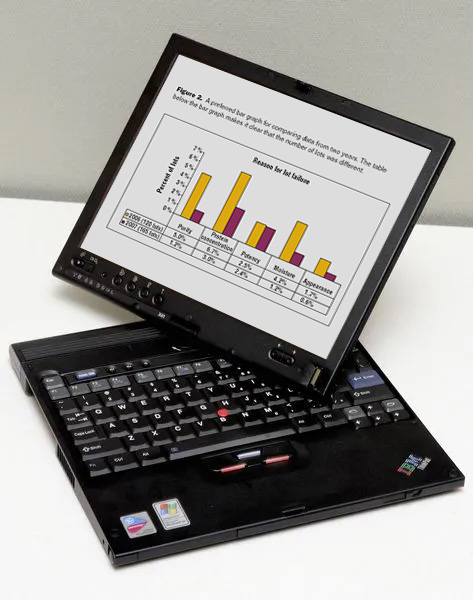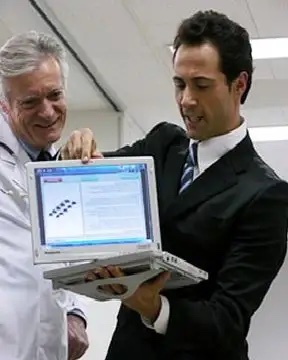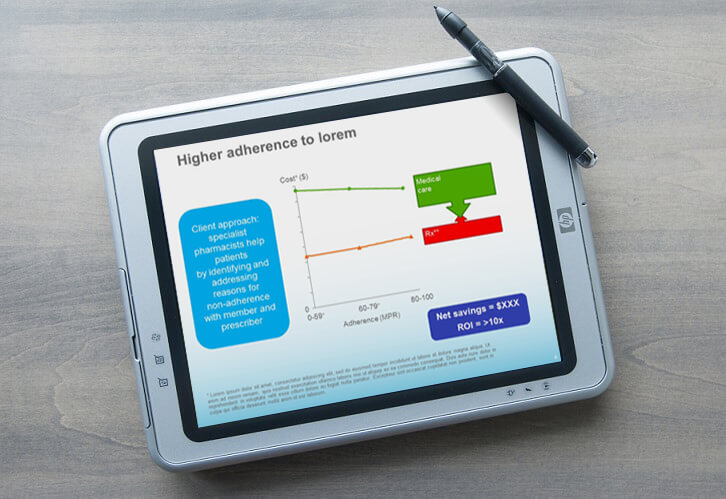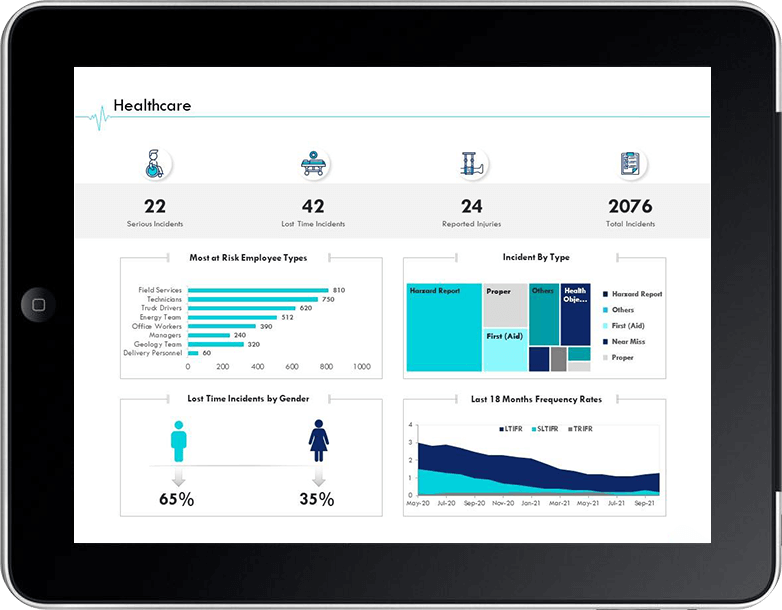From Static to Dynamic: The Evolution of CLM eDetails in the Pharmaceutical Industry
13 May 2024 by Leo Miller

What is eDetailing?
eDetailing is the use of digital sales aids and software on tablets, laptops, and mobile devices designed to engage and educate healthcare professionals about pharmaceutical products and services. It emerged as a replacement for traditional print-based detailing, which relied on paper "leave behind" such as brochures and flyers.
eDetails are known by many names including eADV, DSA, CLM, Digital Sales Aids, electronic visits, e-visits, pharmaceutical detailing, e-detailing and even electronic detailing. Whatever word you use, this article looks at the history and evolution of eDetailing and gives us some clues as to what may come next.

Figure 1. Cholesterol Flip Chart, 3B Scientific, accessed May 9, 2024, https://www.3bscientific.com/gb/cholesterol-flip-chart-1018306-w43208-43117,p_1097_17418.html.
Pre-2000s: Printed Sales Aids, before the digital age
Before the digital age, pharma sales reps relied on printed brochures, visual aids, and other physical materials to present information to physicians about their products. These printed sales aids served as the primary tools for sales reps to educate doctors, showcasing clinical data, and product samples, and ultimately supporting the rep to convince the doctor to recommend and prescribe their medicines.
The sales aids tended to be glossy, colourful brochures containing images, charts, and bulleted text to highlight the benefits and differentiate the features of a particular medicine. Sales reps would carry boxes of these sales aids in their cars and hand them out during visits with doctors.
Creating and distributing printed sales aids was an expensive endeavour for organisations. Not only did they have to bear the printing costs, but the materials were static and could not be easily updated. Any time new clinical data or prescriber information (PI) needed to be shared, new brochures had to be printed and shipped out to the entire salesforce.
Despite being limited in their ability to present interactive or dynamic content, these printed sales aids were indispensable tools for reps. They enabled face-to-face marketing of drugs at an HCPs office and served as take-home reference guides for physicians.

Figure 2. Ted Anthony, ThinkPad X41 2005, Go Upstate (Herald-Journal, n.d.), https://eu.goupstate.com/story/news/2005/08/01/thinkpad-tablet-gets-it-right-first-time/29765849007/.
## Early 2000s: Adoption of Tablet PCs for detailing
In the early 2000s, sales teams adopted tablet PCs and laptops to present promotional materials to doctors. This allowed them to move away from printed binders and flip charts and start presenting digital sales aids.
The portability and convenience of tablets enabled sales reps to easily carry and navigate through visual sales presentations. They could showcase product information, clinical trial data, dosage guides and more. Tablets also allowed reps to quickly pull up customised materials for different doctor specialities or interests.
Major pharmaceutical companies began equipping their sales teams with Windows-based tablets. The tablets were loaded with sales presentation software and product catalogues. This digital shift improved efficiency and helped reps deliver more interactive and engaging details to customers.
While the content was still generally static, the tablet format allowed greater flexibility and customisation in sales calls compared to printed materials. It also provided a bridge to more advanced digital detailing capabilities in the future through cloud computing and data integration.

Figure 3. James Bowden, Pharma Sales Rep, Top Dog Medical Professionals, accessed May 9, 2024,Topdogmedicalprofessionals.org, Hub Pages, accessed May 9,2024,discover.hubpages.com/business/What-Does-A-Pharmaceutical-Sales-Representative-Do.
## Mid 2000s: Multimedia and Interactivity come to eDetails
In the mid-2000s, pharmaceutical companies began adopting multimedia and interactivity into their sales aids on tablets. This allowed sales reps to showcase video demos, 3D models, modes of action animations and other interactive elements during their sales calls with doctors.
The ability to bring dynamic and engaging content into the conversation helped sales reps better explain product features, and show clinical trial data, mode of action and other details. It provided a more immersive experience for doctors to understand the products compared to static brochures and flipbooks.
Some key innovations in multimedia eDetails from this period include:
- Video demos: Showing the product in use through video helped doctors to visualise real-world applications.
- Animated infographics: Complex clinical trial data and mode of action animations improved comprehension.
- 3D molecular models: Detailed 3D renderings of drug compounds allowed for interactive viewing and manipulation.
- Quizzes and assessments: Interactive quizzes helped reinforce learning and provided feedback.
- Built-in calculators: Tools for calculating dosages, risk factors and other metrics assisted with decision-making.
- Branded content Cohesive branding, videos and imagery aligned the experience with marketing campaigns.
This interactivity and multimedia content enriched the conversations between sales reps and doctors during meetings. It helped reps showcase the unique value propositions of products in more engaging ways through the latest software and hardware capabilities.

Figure 4. Mayank Parmar, HP Compaq Tablet, Windows Latest, accessed 2024, https://www.windowslatest.com/2017/11/01/forget-windows-10-unsupported-windows-xp-increased-market-share/
## Late 2000s: Cloud-Based eDetailing in Pharma
In the late 2000s, the Life Sciences industry began to adopt cloud-based solutions, hosted online through a software-as-a-service (SaaS) model, like Veeva CRM. Rather than installing software locally, sales reps could now access multimedia sales aids through a web browser on any device.
Cloud-based eDetailing provided several key advantages:
- Centralised hosting reduced IT burden for pharma companies compared to on-premise installations
- Automatic updates and new features were rolled out seamlessly via updates without reps needing to manually install or configure anything.
- Sales reps could access the latest approved content from any device with an internet connection. Many applications, such as Veeva CRM, worked offline, meaning an internet connection was not needed to show content to a customer.
- Analytics and reporting were improved through aggregated use data in the cloud.
- Scaling the number of users was easier without on-premise infrastructure limitations.
By removing the challenges and costs of on-premise software management, cloud software enabled sales reps to focus on selling while ensuring they always had the most up-to-date content and tools. This transition to SaaS helped pave the way for the rapid adoption of eDetailing across the industry.

Figure 5. eDetail - iPad 1st Generation, Pulse Digital Ltd.
## 2010s: Mobile Optimisation and HCP engagement
In the early 2010s, pharma organisations began optimising their eDetailing platforms and content for mobile devices like iPads and smartphones. This enabled sales reps to access interactive visual aids, videos, and other digital content directly on their mobile devices when meeting with physicians in the field or at their offices.
Key benefits of the mobile optimisation period included:
- Increased portability and convenience for sales reps to carry eDetails on a tablet or phone versus print materials or laptops.
- Faster loading and smoother performance of interactive eDetail content on mobile versus older platforms.
- Ability to take full advantage of touch interfaces on tablets and mobile.
- Optimization for smaller screens like iPads allowed a more focused, guided presentation.
- Mobile eDetails aligned with increasing physician adoption of tablets and smartphones.
By the mid-2010s, most major pharma companies had transitioned their sales forces to utilising eDetails on mobile devices and tablets. This enabled a more dynamic, digital sales experience compared to traditional print detailing. Mobile optimisation paved the way for the modern, app-driven platforms used by most life sciences companies today.
-pulse-digital-ltd.png)
Figure 6. Breathe eDetail - iPad Pro (2022), Pulse Digital Ltd.
## Present Day: Data-Driven eDetails and the era of customer engagement
The eDetailing and CLM solutions of today leverage data and analytics to create personalised, relevant experiences for each healthcare professional. By integrating CRM data, sales intelligence, and other systems, platforms such as Veeva CLM can automatically customise content for individual needs and interests.
For example, usage data may reveal that an oncologist frequently prescribes a certain chemotherapy drug. The system can then highlight clinical trial results and dosing information for that drug in the eDetail.
Likewise, if a physician has shown interest in a particular disease state, the rep can instantly pull up related materials. This ensures they deliver the information the doctor wants and needs.
These applications also enable reps to track eDetail performance through engagement analytics. They can see which content gets viewed the most and can modify their approach accordingly.
The data-driven model allows reps to have more meaningful conversations with healthcare providers. Instead of a generic sales pitch, they deliver personalised value. eDetails today are all about the right content for the right customer at the right time.
-pulse-digital-ltd.jpg)
Figure 7. Breathe eDetail Veeva CRM - iPad Pro (2022), Pulse Digital Ltd.
## Conclusion
The evolution of eDetails from printed sales aids to today's data-driven multimedia experiences on mobile devices has transformed the pharmaceutical sales process. What started as simple PDFs has become a dynamic tool harnessing the power of the cloud, interactivity, and analytics.
The possibilities are exciting as eDetails continue to leverage emerging technologies. However, the core benefits of convenience, customisation, and insight will remain central. Platforms like Veeva CRM have played a key role in the evolution of eDetails and will continue shaping the future in partnership with life sciences companies aiming to enhance effectiveness and exceed customer expectations. Whilst the format has changed dramatically, the focus on engaging, informing and educating healthcare professionals will endure.

Leo Miller
I am a proven leader of digital marketing strategy and business transformation; effectively engaging businesses and brands to integrate innovative digital solutions and accelerate their capabilities.
I have extensive and varied experience ranging from founding start-ups to navigating the complexity of some of the world’s largest organisations. I have previously led Digital Strategy and transformation at GSK, Reckitt Benckiser, and L’Oréal. I now lead the Customer Success team at Pulse, helping healthcare and pharma organisations drive value from the use of digital and its associated technologies.
